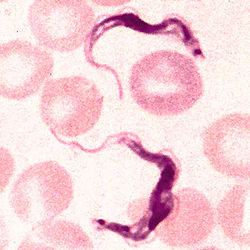| Trypanosoma brucei |
|---|
 |
| Scientific Classification |
|
| Species |
| Trypanosoma brucei |
Trypanosoma brucei is a unique protist usually found infecting the bloodstream of a tsetse fly. It is the leading cause of a sleeping disease in Africa known as trypanosomaisis, in which the patient will suffer through the struggle of staying awake during the day and trying to sleep at night. Most patients get horrible symptoms that include swelling, headaches, rashes, and many other symptoms to keep them unable to sleep. This disease is fatal if untreated, and is passed by tsetse flies. No one knows exactly how the trypanosomes infect the flies, for the flies can be infected as well as humans and animals. Trypanosoma can infect both by being inside of the human at the time a fly takes blood from the human. Thus, Trypanosoma is in a constant cycle of living in hosts and can not be traced to an original source. This is one sleep-depriving parasite you don't want to mess with.
Anatomy
Trypanosoma brucei is a unique protist that is commonly found in Africa, but more precisely in a tsetse fly. The trypanosomes,(typical parasitical protists) will infect a tsetse fly as its first host, in which it will go through many transformations until it is ready for its second infectious stage. When in its second infectious stage, it will find a human or animal host (of course through the aid of the tsetse fly biting the host) and swarm though that hos; this will cause the victim to undergo the disease of trypanosomiasis: the disease in which the victim will have problems staying awake during the day and have disturbances during the night, such as headaches, sore muscles, rashes, sores, swelling of body parts and a few other symptoms as well. [1]
Reproduction
Because most trypanosomes live inside flies (due to information that is otherwise unknown to scientists), they have a great chance for reproduction. The trypanososmes begin their first stages of life and transformation in the tsetse flie's stomach. Before their sexual reproduction occurs, the trypanosomes will undergo a transformation which they will utilize their for travel. This enables the trypanosomes so swim through the typical tsetse flie's complex digestion system, which allows them the freedom to migrate all the way from the stomach to the saliva glands of the fly. It is in this cycle that the trypanosomes will perform sexual reproduction, thus increasing the infected blood of the fly and increasing the chance of infecting any poor soul bitten by the fly. [2]
Ecology

Reproduction of T. brucei takes place through binary fission inside the fly's midgut. Once the parasite reaches the fly’s salivary gland, it attaches the flagella to the wall of the salivary gland and undergoes morphological changes into a form capable of infecting mammalian hosts.
When they, by chance of the tsetse fly finding a human, infect the human bloodstream, they change into trypomastigotes (another necessary transformation), migrate to various areas of in the human and attempt to multiply in the fluids of the human (such as cartilage, spinal fluid.. etc..). After this transformation into trypomastigotes has occurred inside the human, and with the right conditions such as a tsetse fly attempting to have a second "snack" on the human, the fly will be infected by trypanosoma a second time! With that factor falling into place, this creates a never ending cycle of the trypanosomes infecting, changing, multiplying, changing again, and infecting several hosts.[3]
Trypanosomiasis
Trypanosomiasis is a disease called the "sleepers disease" and can be caught in both West and East Africa. Luckily, the disease is only passed from tsetse flies which are only found in Africa. When a victim is bitten by a trypanosome infected fly, a red sore develops around the bite and nearly within two weeks after this occurs, the infection may cause the presence of rashes, sores, headaches, sore muscles with sore joints and body parts, and anything that can keep someone up late at night. The infection may also spread to the central nervous system, causing the patient to feel irritability or have trouble walking and talking, as if his motor skills have been temporarily paralyzed. If that isn't enough, the victim will also have trouble speaking or have seizures; making Trypanosomiasis a fatal infection. But due to modern science, we have found its cure.[4] [5]
References
- West African Trypanosomiasis Author unknown. Centers for Disease Control and Prevention - Division of Parasitic Diseases. June 6, 2008.
- [6] Wendy Gibson/Mick Bailey. BioMed Central Ltd.
- [7] Prescott, Harley, Klein. McGraw Hill Companies.
See Also
|
||||||||||||||||||||




